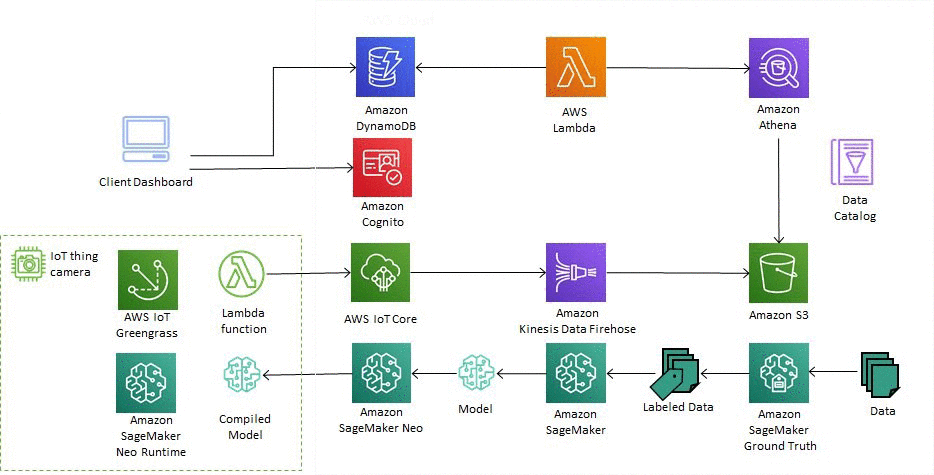Amazon SageMaker Neo Helps Detect Objects and Classify Images on Edge Devices
Nomura Research Institute (NRI) is a leading global provider of system solutions and consulting services in Japan and an APN Premium Consulting Partner. NRI is increasingly getting requests to help customers optimize inventory and production plans, reduce costs, and create better customer experiences. To address these demands, NRI is turning to new sources of data, specifically videos and photos, to help customers better run their businesses.
For example, NRI is helping Japanese convenience stores use data from in-store cameras to monitor inventory. And, NRI is helping Japanese airports to optimize people flow based on traffic patterns observed inside the airport.
In these scenarios, NRI needed to create a machine learning models that detects objects. NRI needed to detect goods (drinks, snacks, paper products, etc.) and people that leave stores for retailers, and commuters for airports.
NRI turned to Acer and AWS to meet their goals. Acer aiSage, is an edge computing device that uses computer vision and AI to provide real-time insights. Acer aiSage makes use of Amazon SageMaker Neo, a service that lets you train models that detect objects and classify images once and run them anywhere, and AWS IoT Greengrass, a service that brings local compute, messaging, data caching, sync, and machine learning inference capabilities to edge devices.
“One of our customers, Yamaha Motor Co., Ltd., is evaluating AI-based store analysis and smart store experience.” said Shigekazu Ohmoto, Senior Managing Director, NRI. “We knew that we had to build several computer vision models for such a solution. We built our models using MXNet GluonCV, compiled the models with Amazon SageMaker Neo, and then deployed the models on Acer’s aiSage through AWS IoT Greengrass. Amazon SageMaker Neo reduced the footprint of the model by abstracting out the ML framework and optimized it to run faster on our edge devices. We leverage full AWS technology stacks including edge side for our AI solutions.”
Here is how object detection and image classification works at NRI.

Amazon SageMaker is used to train, build, and deploy the machine learning model. Amazon SageMaker Neo makes it possible to train machine learning models once and run them anywhere in the cloud and at the edge.
Amazon SageMaker Neo optimizes models to run up to twice as fast, with less than a tenth of the memory footprint, with no loss in accuracy. You start with a machine learning model built using MXNet, TensorFlow, PyTorch, or XGBoost and trained using Amazon SageMaker. Then, choose your target hardware platform. With a single click, Amazon SageMaker Neo compiles the trained model into an executable.
The compiler uses a neural network to discover and apply all of the specific performance optimizations to make your model run most efficiently on the target hardware platform. You can deploy the model to start making predictions in the cloud or at the edge.
At launch, Amazon SageMaker Neo was available in four AWS Regions: US East (N. Virginia), US West (Oregon), EU (Ireland), Asia Pacific (Seoul). As of May 2019, SageMaker Neo is now available in Asia Pacific (Tokyo), Japan.
To learn more about Amazon SageMaker Neo, see the Amazon SageMaker Neo webpage.
About the Authors
 Satadal Bhattacharjee is Principal Product Manager with AWS AI. He leads the Machine Learning Engine PM team working on projects such as SageMaker Neo, AWS Deep Learning AMIs, and AWS Elastic Inference. For fun outside work, Satadal loves to hike, coach robotics teams, and spend time with his family and friends.
Satadal Bhattacharjee is Principal Product Manager with AWS AI. He leads the Machine Learning Engine PM team working on projects such as SageMaker Neo, AWS Deep Learning AMIs, and AWS Elastic Inference. For fun outside work, Satadal loves to hike, coach robotics teams, and spend time with his family and friends.
 Kimberly Madia is a Principal Product Marketing Manager with AWS Machine Learning. Her goal is to make it easy for customers to build, train, and deploy machine learning models using Amazon SageMaker. For fun outside work, Kimberly likes to cook, read, and run on the San Francisco Bay Trail.
Kimberly Madia is a Principal Product Marketing Manager with AWS Machine Learning. Her goal is to make it easy for customers to build, train, and deploy machine learning models using Amazon SageMaker. For fun outside work, Kimberly likes to cook, read, and run on the San Francisco Bay Trail.
Tags: Archive

Leave a Reply